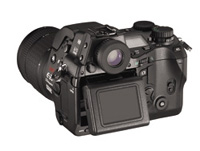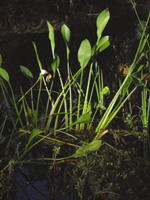Olympus Camedia E 20N
A 5 Megapixel SLR With Super Fast Shutter Speeds, and More
The Olympus Camedia E-20N is the latest in their series of high-end digital cameras that straddle the line between consumer and professional markets. Although the E-20N does not offer interchangeable lenses, it stretches the envelope on the consumer side by offering features and abilities that outstrip most consumer-oriented competitors, albeit with a street price of about $2000. It all begins with a 5-megapixel chip, one that can deliver a near 15MB file that yields amazingly sharp 8x10 and highly credible 12x16" prints. It also allows considerably more image controls with its very fast shutter speed capability and aperture settings that can be controlled in 1/3 EV increments from f/2 to f/11 (wide angle, f/2.8 at tele). Other highlights include a strong built-in flash (good for up to 20 ft in the default ISO 80 setting), SLR like viewing and control, a dual AF system, and enough metering and exposure compensation controls to satisfy the most demanding photographer. The all-aluminum body is a decidedly photographic matte black and there's a reticulating monitor on the back that allows you to work from all sorts of interesting angles. |
|||
IP And SP Image Modes The importance of this for image effects control cannot be overstated. It allows you to work with a wide range of apertures for getting just the depth of field you might want in your shots. Most digicams (non SLRs) limit you to two apertures at most, with some topping out at f/5.6. And of course you get a very wide range of shutter speeds for various depictions of motion and working in low light. Combine a 60 sec shutter speed with an f/2 lens and you can be deep in the woods with plenty of light to spare. Another aspect of the camera that plays into the above is the Olympus Noise Reduction System. You can only use it with shutter speeds at or slower than 1/2 sec, but it all but eliminates the noise you'd usually get in such circumstances. |
|||
Camera Controls And Layout This memory problem is not unique to the E-20N. As we get more and more of these 5 megapixel (and higher as we go along) chips some solution to the memory problem will have to be found. Clearly, chip capacity is outstripping memory capabilities. The reason we shell out money for these larger chip capacity cameras is that we want to take advantage of the resolution they afford. Right now, if you want to take full advantage of this capability you must consider buying either a high-capacity card or an in-the-field download device. That means adding a few hundred more dollars to your camera purchase price right out of the gate. That said, let's get back to our camera tour. |
|||
Confirming Settings Drive And Self-Timer The top button of the two allows you to set the metering mode, or how the exposure system reads light. The metering pattern set is conditional on the subject and lighting in the scene. ESP is an evaluative mode and reads all the brightness values in the scene to arrive at an exposure. This is the full auto setting and is very good at what it does. The other two choices are center-weighted averaging and spot metering. Use center-weighted and exposure lock (the AEL button on the upper right back of the camera) for reading then placing brightly lit subjects off-center to have the exposure biased for that subject. Use spot for very selective readings, indicated by the circle surrounding the AF mark in the finder. For a sort of "real time" view of the effect of exposure changes you can switch to manual exposure mode and use the monitor. As you toggle through shutter speed changes you see the monitor get darker or brighter. The most effective use of this is when you want to play with exposure compensation. As you toggle through in manual the exposure compensation off the recommended exposure is shown on the finder as plus and minus values. The monitor, however, does not always correlate directly with results, as the brightness of the monitor itself may or may not be exactly what records. I found this particularly true with flash exposures. Many looked washed out and overexposed, but when I downloaded them later they came up as perfect exposures. This can be befuddling, and I often took more pictures than I needed to, thinking that I blew the initial shot. It's just something you have to get used to and, again, this is not rare with digicams. Underexposed images on the preview were closer to what came up when downloading. In both cases, slight adjustment seemed to fix the images. Recording Mode Selection There are two sockets on the upper middle left of the camera body that can take connectors. One is a PC terminal for an external flash while the other takes the remote cable jack for the optional Remote Cable RM-CB1. A push button remote (cable-less) comes with the camera. Most other controls on the camera are self-evident, such as WB for White Balance settings, AF/MF for switching between manual and autofocus, and the familiar macro mode and exposure compensation buttons. Inside, via the menu and monitor, there are quite a few features and functions of note that aren't available on the body controls, although some duplicate controls that are available on the body itself. We'll cover some of the ones unique to the menu. Flash Compensation Image Adjust Modes Time Lapse Histograms Olympus has provided a number of accessories for the camera. These include telephoto and wide angle lens adapters, an even closer macro (close-up) lens, and the aforementioned dedicated flash and remote cord. What Olympus does not include in the package is a rechargeable battery solution, and the batteries they give you, the two CR-V3 lithium packs, cannot be recharged. Happily, the E-20N can take AA batteries, so that's where your rechargeable solution comes from. But you can't use lithium or zinc carbon AAs--Olympus says they will overheat and damage the camera--and must stick to NiCd or Ni-MH AA types. An AC adapter and a lithium polymer battery and power battery holder are sold separately. I can live with the use of Ni-MH AAs for rechargeables but the AC adapter is probably important for downloading, as any power interruption during downloading will screw up the operation. So, buy the optional AC adapter or invest in an Olympus floppy adapter for SmartMedia cards and/or card readers for your downloads. The lack of an included AC adapter is, in my view, regrettable. One could argue that the price of this level of camera is kept in check by not including one, but then again one could argue that the price assumes inclusion. In The Field The Contrast image controls are most appreciated, especially when working here in the hot Florida sun. After a first few attempts at photographing during the middle of the day, we switched to low contrast recording mode and were much happier with the results. The monitor always showed the image a bit brighter than we would like on preview, but the histogram tells the true story. The Olympus E-20N is quite a camera. In features it comes close to offering many of the options of a full-fledged digital SLR, while in price it comes in between the top point-and-shoot and the lower end SLRs. In that sense it is a bit of a fence straddler, and may just appeal to the budgets of those seeking the big chip and extensive creative controls without going over the $2000 mark. Whether you want to spend another grand for lens interchangeability and other SLR features is up to you, but you can't go too wrong with this amazingly versatile camera. For more information, contact Olympus America Inc. at (631) 844-5321; fax: (631) 844-5262; www.olympus.com. |
|||
|
- Log in or register to post comments






































